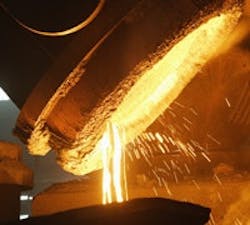Wireless Provides Steelmaker New View of Energy Usage
When folks talk about energy monitoring, they're usually referring to utility bills, watt-hour meters and monitoring flows of fuels and gases. The same holds true at the average steel mill. "Steelmakers usually only measure the energy that ends up in the product," said Dave Smith, business unit manager at Wunderlich-Malec.
But Smith's Thursday morning session at this week's Emerson Global Users Exchange, "CMC Steel Wireless Energy Monitoring System, Cayce, S.C." with Greg Huey, Emerson wireless area sales manager, was about something completely different—a project with UT-Battelle, managing contractor for Oak Ridge National Laboratory (ORNL), to monitor how energy distributes through the steel-making process and discover where it is used, wasted and lost.
On top of that, they wanted to do it with wireless technology. "The overall objective for UT-Battelle ORNL is to facilitate the deployment and installation of wireless sensor networks in the steel industry and to aggregate the produced data to realize and document the resultant energy savings," Smith said.
"We took a small bite of the apple and it was good." Wunderlich-Malec's Dave Smith discussed how, after a successful proof-of-concept trial, wireless instrumentation was rolled out in an electrically noisy environment at CMC Steel.
To do it, Wunderlich-Malec designed and installed a system and network of HART wireless devices to collect process values such as stack gas and cooling water temperatures and flows. The information will be archived and remotely monitored by UT-Battelle ORNL and used in energy-related performance calculations. The plant studied its priorities and selected the melt shops and their electric arc furnaces for the initial implementation.Due in part to the arcs themselves, "Steel mills are noisy environments," Smith said. A full wireless site survey looked for potential sources of interference and found significant amounts of amplitude-modulated (AM) noise. "That shouldn't be a problem," Smith said, but with a plan to install as many as 1,000 I/O and distances ranging up to 850 feet, "We thought it was very important to find out if the technologies we thought would work actually would work."
A proof-of-concept test was performed by hanging a few transmitters and a gateway. "We took a small bite of the apple," Smith said, "and it was good." They proceeded to train the installers and perform the implementation, which was completed in August. Smith's only disappointment came on the day of the acceptance test: Testing began at 8 a.m. and by the time he showed up at 10 a.m., it was already done. He missed it.
Now CMC Steel has a reliable HART wireless infrastructure and access to process instrument signal values that will help the company review operation and energy performance efficiency. SCADA software collects and stores data from the plant site and provides remote access to both UT- Battelle ORNL and CMC. They have the ability to view the operation status on-line, see health and history of instrumentation signals and to retrieve stored data for downloading and calculations at ORNL.
Using wireless minimized the field installation time and reduced the quantity of wiring/conduit to connect to the SCADA system. Process data can be transferred to higher-level UT- Battelle ORNL systems in standard SQL database files via a VPN behind a firewall.
The steel industry is very globally competitive, and the project's objective is to lower the cost of production by a significant amount: $1 per ton. When CNC saw the information coming from the wireless monitors, "We realized that this system would provide a new way of seeing into the plant," Smith says, "a way for U.S. industry to have what it needs to know to be competitive in the global marketplace."
Next on the list for this tracking and analysis—the rolling mill.



